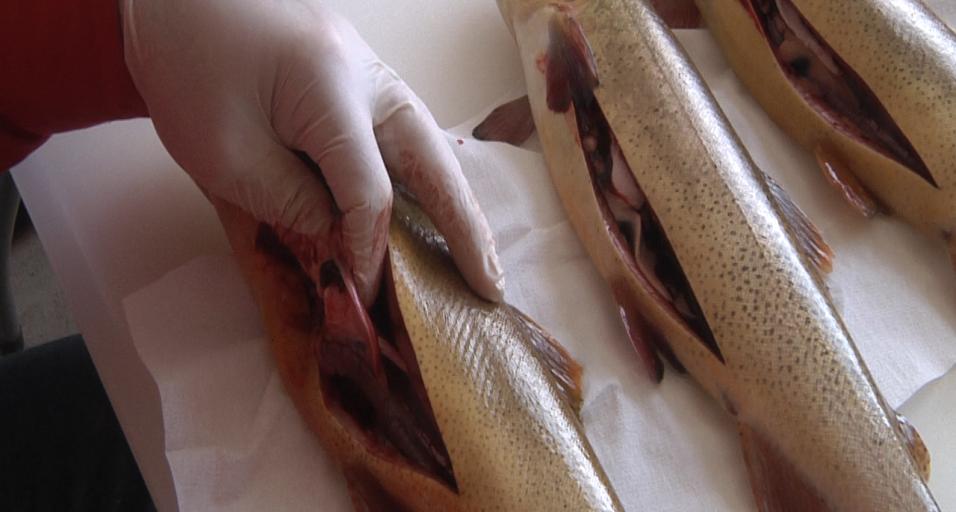From egg to hook, keeping fish healthy in Wyoming waters is a main priority for the Wyoming Game and Fish Department and is one way the Wildlife Forensics and Fish Health Laboratory in Laramie benefits the public. Often, this starts within the hatchery, where the Fish Health section of the Wildlife Forensics and Fish Health Laboratory conducts annual inspections. These inspections ensure the fish you reel in are high-quality, healthy, and good enough to eat.
The Fish Health section annually inspects the 10 state hatcheries, six commercial facilities, four isolation facilities, and six feral brood populations in Wyoming: Flaming Gorge, Meadow Lake near Pinedale, North Piney, Boysen Reservoir, Salt River, Bar BC Creek.
“The purpose of these inspections is to ensure the overall health of fish in Wyoming waters,” said Tim Pridmore, fish health inspector for the Wildlife Forensics and Fish Health Laboratory also known as simply the Lab. “The results help biologists determine what steps might need to be made in order for our hatcheries to produce healthy fish for sportsmen and women to enjoy.”
Staff from the Lab inspect each hatchery at least once a year to check for viruses, bacteria, and parasites in fish. Some hatcheries may be inspected twice if they have different fish species that spawn at different times of the year (some fish species may spawn in the fall and some in the spring). Inspections may also happen more often if there is concern of an outbreak of something like whirling disease.
Each inspection is a lengthy and involved process. Initial prep work involves making sure all equipment is sterilized and in working order. The prep verifies that a checklist of items such as tubes/collection bags, gloves, sterilization equipment, trash bags, isopropanol, paper towels, tools, etc and packed and ready to go. In addition, virology plates need to be made before heading out on the inspection. This process places live fish cells, which are maintained in the lab, onto 24 well plates. The plates need to be prepared before the inspection because they require time to grow across each well on the plates.
Once on site, three types of samples are collected: heads, kidney/spleen and ovarian samples. Ovarian samples are collected while the hatchery crew is spawning by collecting a small amount of fluid from the females when the hatchery crew squeezes the eggs out. Kidney/spleen samples are collected by biopsying dead fish, cutting into the fish and collecting the correct organ. Last, personnel collect fish heads after the fish has been biopsied. All these processes are done aseptically to prevent cross contamination.
“The number of fish we collect varies but generally we take 60. That means if the pathogen we are searching for is prevalent within 5% of the population we should be able to detect it,” said Pridmore. The fish we collect depends on water source, species and age class. All three of these factors are considered when setting up an inspection.”
After Game and Fish collects the necessary samples, it’s time for processing and testing - which includes searching for viruses, bacteria, and parasites. “This is where the real lab work starts,” said Pridmore. “We start by smooshing and diluting the kidney/spleen samples. This involves weighing each bag and running a roller over them to smoosh and mix the sample. After that we add the correct amount of dilution media and transfer the sample to tubes.” The samples in those tubes are then used to seed virology plates and bacteria testing. “We monitor the virology plates for 28 days and we use a variety of testing methods to search for bacteria.”
Pridmore explains that ovarian samples are processed the same way, except they are only subject to virology testing. Heads are digested in order to breakdown and remove all unwanted organic material, and are then examined under a scope for whirling disease spores.
“Ultimately we are doing a presence/absence study for each inspection to determine if a pathogen is there or not. When it comes to sick fish, what we call diagnostic cases, each one is handled uniquely. Like going to the doctor when you are sick, we have to consider so many factors; behavior, appearance, location, temperature, stressors, in lab testing, and more,” said Pridmore. Once the lab testing is done, the staff analyzes the data and writes their report, which is then sent to the fish culture section and biologists to determine the treatment.
Fish health inspections do not only happen in the hatcheries; inspections of feral populations like salmon in Flaming Gorge, grayling in Meadow Lake and trout from various lakes are also tested. The fish are inspected just like hatchery inspections, with the exception that they are placed into isolation units for a given amount a time and then tested again. “Some pathogens require time, or require the fish to be a certain age before they show their ugly heads,” Pridmore explained.
Chief of Fisheries, Mark Fowden noted,“The fish health testing done by Game and Fish Wildlife Forensics and Fish Health Laboratory provides me with the confidence that the Wyoming Game and Fish is stocking healthy fish and not inadvertently spreading diseases to fish in the wild. The results of the inspections they conduct are crucial for maintaining the robust trout fisheries we enjoy in Wyoming.”
To learn more about how the Game and Fish Wildlife Forensics and Fish Health Laboratory helps keep fish healthy, manage wildlife, and stop poaching, see the Game and Fish website and read more of our Wildlife Forensic article series>
Story by: Maragaret James, Wyoming Game and Fish Department.
Keeping fish healthy from hatch to hook
Wyoming Game and Fish (307) 777-4600

